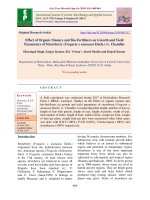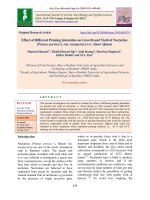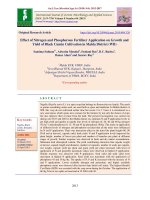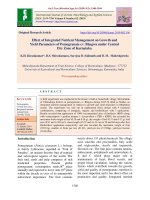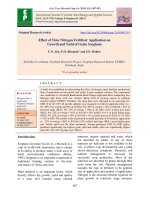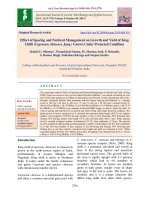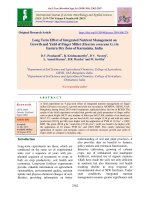Effect of spraying lantana fermented extract on growth and yield of green gram (Vigna radiata L.) in pots
Bạn đang xem bản rút gọn của tài liệu. Xem và tải ngay bản đầy đủ của tài liệu tại đây (171.9 KB, 7 trang )
Int.J.Curr.Microbiol.App.Sci (2018) 7(1): 1187-1193
International Journal of Current Microbiology and Applied Sciences
ISSN: 2319-7706 Volume 7 Number 01 (2018)
Journal homepage:
Original Research Article
/>
Effect of spraying Lantana Fermented Extract on Growth and
Yield of Green Gram (Vigna radiata L.) in Pots
Tanuja I. Ganagi and K.S. Jagadeesh*
Department of Agricultural Microbiology, University of Agricultural Sciences,
Dharwad 580 005, Karnataka, India
*Corresponding author
ABSTRACT
Keywords
Lanatana camara,
Lactic acid bacteria,
Fermentation,
Green gram
Article Info
Accepted:
10 December 2017
Available Online:
10 January 2018
Pot culture evaluation revealed that there was a significant increase in all growth
parameters of green gram due to spraying with the Lanatna fermented extract
(LFE) when compared with both unfermented as well as naturally fermented
extracts. Between the two isolates of Lactic acid bacteria used for fermentation,
DB 27 resulted in the highest values in all parameters. Its spraying twice @ 10 ml
per L was the best treatment resulting in the highest values. It increased
chlorophyll content by about 40 per cent at 45 DAS. Spraying green gram
seedlings with LFE significantly increased pod and grain yield. The highest grain
yield was obtained by spraying twice with Lantana extract, fermented with DB 27
(@ 10 ml per L). Thus, the present investigation has clearly brought out the
potential of LFE in augmenting growth and yield attributes in green gram.
Introduction
Green gram is one of the main pulse crops in
India. The important states producing this
pulse are Madhya Pradesh, Maharashtra, Uttar
Pradesh, Punjab, Andhra Pradesh, Rajasthan,
Karnataka and Tamil Nadu. In 2013, the
United Nations has declared 2016 as the
international year of pulses (IYP 2016)
(). The IYP 2016
promises to be a milestone development in
global pulse trade aiming to focus on the role
of pulses in achieving food security and
nutrition. The IYP program envisages for
better utilization of pulse based proteins, to
increase pulse production worldwide through
different approaches as well as to improve
trade in pulses. Any attempt to increase the
pulse productivity is welcome.
Lantana camara L. is listed as one of the
important medicinal plants of the world. L.
camara is the most widespread species of this
genus, growing luxuriantly at elevations up to
2000 m in tropical, subtropical and temperate
regions. It is an evergreen aromatic shrub and
planted as an ornamental plant around houses.
It has four typical colors: yellow-orange, pink
violet, yellow and white flower types. It is
among the top ten invasive weeds on earth
1187
Int.J.Curr.Microbiol.App.Sci (2018) 7(1): 1187-1193
(Sharma et al., 2005). Species of the genus
Lantana have been used in several
applications in folk medicine. Many studies
have reported that L. camara is a rich source
of many bioactive molecules, and the
phytochemical studies have resulted in the
isolation of many triterpenes, steroids and
flavonoids (Begum et al., 2008). Often, weeds
are seen as a problem rather than beneficial to
the land. Many weeds and herbs are known to
be mineral accumulators and are very
important to the ongoing health of the soil.
Fermentation with microorganisms is known
to yield high value products from raw or low
grade substrates. Fermentation breaks down or
converts the undesirable substrates into
compatible components mediated by microbial
enzymes, thereby improving the substrate
properties via the production and enrichment
of bioactive compounds (Parvez et al., 2006).
Fermentation mediated bio-activation of the
herbal medicines has resulted in improved
therapeutic potencies and efficacies and
decreased toxicities (Wu et al., 2013). It has
been shown that during the course of
Lactobacillus mediated fermentations, organic
acids were released, proteins hydrolyzed and
anti-oxidant ferulic acid from plant cell wall
materials solubilized (Cheigh et al., 1994). It
has been reported that fermentation of
Anoectochilus formosanus using Lactobacillus
acidophilus boosted its anti-oxidant activity
by increasing the total phenol content (Ng et
al., 2011). In another study, fermentation was
used to enhance the antimicrobial potential of
the crude herbal extract of Phyllanthus niruri.
Fermentation was carried out using
Lactobacillus acidophilus. The results
indicated that the antimicrobial potential of the
fermented herb was increased by about 80 per
cent to 170 per cent when compared to the
crude herbal extract (Venugopalan et al.,
2010). Thus, fermentation of any biomass is
known to release nutrients, amino acids,
phenolic phytochemicals and phytohormones.
Hence, an attempt was made to ferment the
biomass of Lantana weed using lactic acid
bacterial (LAB) isolates and to study the effect
of the fermented products on the growth and
yield of green gram under pot cultures.
Materials and Methods
A pot experiment was conducted in the green
house of the Department of Agricultural
Microbiology, University of Agricultural
Sciences, Dharwad, Karnataka, India. It was
laid out in a Completely Randomized Design
(CRD) with 14 treatments and 7 replications.
Treatment details
T1 -T (JH) fermented extract, Spraying once
@ 5 ml/l (30 DAS)
T2 -T (JH) fermented extract, Spraying once
@ 10 ml/l (30 DAS)
T3 -T (JH) fermented extract, Spraying twice
@ 5 ml/l (30 and 45 DAS)
T4 -T (JH) fermented extract, Spraying twice
@ 10 ml/l (30 and 45 DAS)
T5 -DB 27 fermented extract, Spraying once @
5 ml/l (30 DAS)
T6 - DB 27 fermented extract, Spraying once
@10 ml/l (30 DAS)
T7 -DB 27 fermented extract, Spraying twice
@ 5 ml/l (30 and 45 DAS)
T8 -DB 27 fermented extract, Spraying twice
@ 10 ml/l (30 and 45 DAS)
T9 - Water extract (natural fermented),
Spraying once @ 5 ml/l (30 DAS)
T10 -Water extract (natural fermented),
Spraying once @ 10 ml/l (30 DAS)
1188
Int.J.Curr.Microbiol.App.Sci (2018) 7(1): 1187-1193
T11 -Water extract (natural fermented),
Spraying twice @ 5 ml/l (30 and 45 DAS)
T12 - Water extract (natural fermented),
Spraying twice @ 10 ml/l (30 and 45 DAS)
T13 - Spraying Panchagavya as per POP (30
DAS)
T14 - Check (no spraying at all).
Green gram seeds of variety IPM 2-14 were
soaked in the optimized concentration of the
lactic acid bacterial fermented extract for 10
min. The seeds were treated with the
Rhizobium biofertilizer and sown in pots.
After germination, thinning was done to retain
three plants in each pot.
The application of the recommended dose of
FYM and N: P: S fertilizers as well as plant
protection measures were taken up as per the
recommended package of practices. Plant
height, number of leaves per plant, chlorophyll
content and dry matter production were
measured at 45 days after sowing (DAS).
Yield and yield components were measured
after harvest of the crop.
Results and Discussion
The Lantana extract (30%) was prepared and
subjected to fermentation using two selected
lactic acid bacterial (LAB) isolates separately
viz., T9JH) and DB 27, for five days and the
fermented extract filtered (Tanuja, 2017). This
filtrate was used for spraying in the pot
experiment.
The influence of spraying the Lantana
Fermented Extract (LFE) at different
concentrations and different number of times
on growth parameters of green gram was
studied in pots. In general, there was a
significant increase in all the growth
parameters viz., plant height, number of leaves
and dry matter production due to spraying
with the fermented extracts when compared
with both unfermented extract as well as
naturally fermented extracts (Table 1). Again,
between the two isolates, DB 27 resulted in
the highest values in all the parameters. And,
spraying twice @ 10 ml/l was the best
treatment yielding the highest values. It
increased cholorophyll content by about 10 to
12 per cent at 30 DAS and up to 40 per cent at
45 DAS. LFE fermented with DB-27 isolate is
enriched with phytohormones, NPK nutrients
and other phytochemicals (Tanuja, 2017). All
these constituents would have resulted in
enhanced growth parameters and chlorophyll
content as well.
Lantana fermented extracts can be considered
as biostimulants. Biostimulants are extracts
obtained from organic raw materials
containing bioactive compounds.
The chief components of the biostimulants
include mineral elements, humic acids and
protein hydrolysates (Hamza and Suggars,
2001; Kauffman et al., 2007).
Biostimulants are known to act at low
concentrations (Zhang and Schmidt, 1999).
The effect of a biostimulant depends on
environmental factors, and on the dose and
time of application (Kunicki et al., 2010).
Application of biostimulants is known to
increase the color of leaves by stimulating the
chlorophyll content. This effect was observed
in cowpea seeds pre-soaked in carrot extract
(Abbas and Akladious, 2013).
Chlorophyll levels were increased and
carotenoids were doubled in Rocket vegetable
(Eruca sativa) when treated with Moringa
oleifera extract (Abdalla, 2013). High
concentration of leaf pigments resulting from
biostimulant treatments in rocket has also been
observed by Vernieri et al., (2006).
1189
Int.J.Curr.Microbiol.App.Sci (2018) 7(1): 1187-1193
Table.1 Effect of Lantana fermented extract on growth parameters and chlorophyll content of
green gram in pots (45 DAS)
Treatment
Plant
height
(cm/
plant)
22.07
No. of leaves
per plant
Dry matter
accumulation
(g /plant)
16.37
0.73
Chlorophyll
content
(SPAD value
per plant)
48.5
24.75
21.00
0.75
48.7
26.00
22.75
0.77
51.2
27.25
23.75
0.79
51.7
26.17
21.65
0.80
53.7
26.75
22.52
0.82
54.2
27.80
24.57
0.84
56.1
30.02
25.27
0.86
58.2
17.25
15.30
0.61
45.1
20.25
18.37
0.63
45.4
22.70
22.37
0.64
45.7
24.25
22.87
0.66
46.3
21.25
19.17
0.54
43.7
17.12
15.37
0.52
41.3
S. Em. +
0.37
0.31
0.01
0.67
C.D. at 1%
1.41
1.21
0.04
2.57
T1 - (T(JH) LFE spraying
once @ 5 ml/l)
T2 - (T(JH) LFE spraying
once @ 10 ml/l)
T3 - (T(JH) LFE spraying
twice @ 5 ml/l)
T4 - (T(JH) LFE spraying
twice @ 10 ml/l)
T5 - (DB-27 LFE spraying
once @ 5 ml/l)
T6 - (DB-27 LFE spraying
once @ 10 ml/l)
T7 - (DB-27 LFE spraying
twice @ 5 ml/l)
T8 - (DB-27 LFE spraying
twice @ 10 ml/l)
T9 - (NFE spraying once @
5 ml/l)
T10 - (NFE spraying once
@ 10 ml/l)
T11 - (NFE spraying twice
@ 5 ml/l)
T12 - (NFE spraying twice
@ 10 ml/l)
T13 - Spraying
panchagavya
T14 – Check
Note: DAS - days after sowing
LFE - Lantana fermented extract
NFE - Natural fermented extract
1190
Int.J.Curr.Microbiol.App.Sci (2018) 7(1): 1187-1193
Table.2 Effect of Lantana fermented extracts on yield and
Yield components of green gram at harvest
Treatment
No of
pods per
plant
16.67
Pod
weight
(g/plant)
9.21
No of
seeds per
pod
9.67
Grain yield
(g/plant)
T2 - (T(JH) LFE spraying once @ 10
ml/l)
17.33
9.67
10.33
6.65 (46.7)
T3 - (T(JH) LFE spraying twice @ 5
ml/l)
18.33
9.93
10.67
7.03 (55.1)
T4 - (T(JH) LFE spraying twice @
10 ml/l)
19.33
10.29
11.00
8.18 (80.5)
T5 - (DB-27 LFE spraying once @ 5
ml/l)
20.33
10.57
10.67
7.83 (72.8)
T6 - (DB-27 LFE spraying once @ 10
ml/l)
21.33
10.87
11.33
9.04 (99.5)
T7 - (DB-27 LFE spraying twice @ 5
ml/l)
22.33
11.01
11.67
9.47 (109.0)
T8 - (DB-27 LFE spraying twice @
10 ml/l)
23.00
11.17
12.00
10.58 (133.5)
T9 - (NFE spraying once @ 5 ml/l)
15.00
9.13
9.67
5.26 (16.1)
T10 - (NFE spraying once @ 10 ml/l)
16.00
9.20
10.00
6.24 (37.7)
T11 - (NFE spraying twice @ 5 ml/l)
16.67
9.66
10.33
6.64 (46.5)
T12 - (NFE spraying twice @ 10 ml/l)
17.33
9.90
10.67
4.92 (47.4)
T13 - Spraying panchagavya
14.33
8.70
9.33
4.53 (8.6)
T14 – Check
13.33
8.61
9.00
5.68
S. Em. +
0.267
0.24
0.285
0.16
C.D. at 1%
1.05
0.97
1.120
0.63
T1 - (T(JH) LFE spraying once @ 5
ml/l)
Note: DAS - days after sowing
LFE - Lantana fermented extract
NFE - Natural fermented extract
Values in parantheses indicate per cent increase values over the control
1191
5.68 (25.3)
Int.J.Curr.Microbiol.App.Sci (2018) 7(1): 1187-1193
Flavonoids are secondary metabolites of plants
with polyphenolic structure. They are
synthesized by the polypropanoid pathway and
the startup component is phenylalanine
molecule.
They constitute a wide range of substances that
play an important role in protecting biological
systems against the harmful effects of oxidative
processes on macromolecules, such as
carbohydrates, proteins, lipids and DNA
(Halliwell and Gutteridge, 1989).
Recently, phenolics and flavonoids have been
considered as great antioxidants and proved to
be more effective than vitamin C, E and
carotenoids (Dai and Mumper, 2010). Phenols
are also known to modify the endogenous levels
of phytohormones (Kefeli and Dashek, 1984)
which thereby influence various plant processes
leading to improved yield and quality of seeds.
Foliar spraying of Brassica juncea with
phenolic compounds, namely RD brown and
resorcinol (200µg ml-1 each) modified canopy
structure of plants by increasing primary,
secondary and tertiary branching (Setia et al.,
1991).
The seed yield per plant was also increased
greatly mainly due to significant increase in
number of inflorescences and siliquae per plant,
100 seed weight and number of seeds per
siliqua with these treatments.
A perusal of Table 2 indicated that spraying
green gram seedlings with LFE significantly
increased pod and grain yield.
The highest grain yield was obtained with the
spraying of LFE, fermented with DB 27,
sprayed twice @ 10 ml/l. This may be attributed
to the fact that the LFE is rich in NPK plant
nutrients,
phytohormones
and
other
phytochemicals. The LFE, when sprayed,
stimulated microbial activities and, in turn, the
soil enzymatic activities (Tanuja, 2017). All
these would have ultimately reflected on the
increased seed germination, growth and yield
attributes of green gram. Biostimulants are
known to act directly on the plant physiology
and metabolism or indirectly by improving the
soil conditions (Nardi et al., 2009).
Biostimulants in soils improve the microflora
and, thus, provide positive influence on plant
growth.
These products are usually applied in addition
to standard fertilization treatments to improve
the nutrient use efficiency and products quality
(Heckman, 1994).
Thus, the findings of the preset investigation
have clearly brought the potential of LFE in
augmenting growth and yield attributes in green
gram.
References
Abbas, S. M. and Akladious, S. A., 2013.
Application of carrot root extract induced
salinity tolerance in cowpea (Vigna
sinensis L.) seedlings. Pakistan Journal
of Botany. 45: 795-806.
Abdalla, M. M., 2013. The potential of Moringa
oleifera extract as a biostimulant in
enhancing the growth, biochemical and
hormonal contents in rocket (Eruca
vesicaria sub sp. sativa) plants.
International Jouranl of Plant Physiology
and Biochemistry. 5: 42-49.
Begum, S., Zehra, S. Q. and Siddiqui, B. S.,
2008. Two new pentacyclic triterpenoids
from Lantana camara Linn. Chemical
Pharmocology. 56: 1317-1320.
Cheigh, H., Kun, Y. P. and Lee, C. Y., 1994.
Biochemical,
microbiological,
and
nutritional aspects of kimchi (Korean
fermented vegetable products). Critical
Reviews in Food Science and Nutrition.
34(2): 175-203.
Dai, J., and Mumper, R. J., 2010. Plant
phenolics extraction, analysis and their
antioxidant and anticancer properties.
Journal of Molecules. 15(10): 7313-7352.
Halliwell, B. and Gutteridge, J. M. C., 1989. In
free radicals in biology and medicine,
Oxford University Press, Oxford (UK).
1192
Int.J.Curr.Microbiol.App.Sci (2018) 7(1): 1187-1193
Hamza, B. and Suggars, A., 2001.
Biostimulants: myths and realities.
Turfgrass Trends. 10: 6-10.
Heckman, J. R., 1994. Effect of an organic
biostimulant on cabbage yield. Journal of
Home Consumer Horticulture. 111-113.
Kauffman, G. L., Kneivel, D. P. and Watschke,
T. L., 2007. Effects of a biostimulant on
the heat tolerance associated with
photosynthetic
capacity,
membrane
thermostability
and
polyphenol
production of perennial rye grass. Crop
Science. 47: 261-267.
Kefeli, V. I. and Dashek, W. V., 1984. Nonhormonal stimulators and inhibitors of
plant growth and development. Biological
Reviews, 59: 273-288.
Kunicki, E., Grabowska, A., Sekara, A. and
Wojciechowska, R., 2010. The effect of
cultivar type, time of cultivation, and
biostimulant treatment on the yield of
spinach (Spinacia oleracea L.). Folia
Horticulture. 22: 9-13.
Nardi, S., Carletti, P., Pizzeghello, D. and
Muscolo, A., 2009. Biological activities
of humic substances; in biophysicochemical processes involving natural
nonliving organic matter in environmental
systems. Natural Journal. 2: 305-340.
Ng, E. W., Mare, Y. and Phillip, T., 2011.
Effects of yogurt starter cultures on the
survival of Lactobacillus acidophilus.
International
Journal
of
Food
Microbiology. 145(1): 169-75.
Parvez, S., Malik, K. A., Kang, S. and Kim, H.
Y., 2006. Probiotics and their fermented
food products are beneficial for health.
Journal of Applied Microbiology. 100(6):
1171-1185.
Setia, R. C., Neelam, R. S. and Malik, C. P.,
1991. Effect of phenolic compounds on
growth, yield and quality of Indian
mustard (Brassica juncea). Proceedings
of Indian National Science and academy,
57(6): 407-412.
Sharma, G. P., Raghubanshi, A. S. and Singh, J.
S., 2005. Lantana invasion: An overview.
Weed Biology and Management, 5: 157167.
Tanuja, I. Ganagi, 2017. Effect of lactic acid
bacterial fermented Lantana camara
extract on the growth and yield of Green
gram (Vigna radiata L.). MSc Thesis
submitted to University of Agricultural
Sciences, Dharwad, India.
Venugopalan, V., Dinesh, M. S. and Geetha, K.
S., 2010. Enhancement of antimicrobial
potential of Phyllanthus niruri by
fermentation. Journal of Herbal Medicine
and Toxicology, 4(2): 167-175.
Vernieri, P., Ferrante, A., Borghesi, E. and
Magnani, G., 2005. High quality
flowering plants using the biostimulants.
Informatory Agrarian. 16: 57-60.
Wu, T. X., Wang, N., Zhang, Y. and Xu, X. B.,
2013. Advances in the study on microbial
fermentation and transformation of
traditional Chinese medicine. African
Journal of. Microbiological Research.
7(17): 1644-1650.
Zhang, X. and Schmidt, R. E., 1999.
Biostimulating
turfgrasses.
Ground
Maint, 34: 14-32.
How to cite this article:
Tanuja I. Ganagi and Jagadeesh, K.S. 2018. Effect of Spraying Lantana Fermented Extract on
Growth and Yield of Green Gram (Vigna radiata L.) in Pots. Int.J.Curr.Microbiol.App.Sci. 7(01):
1187-1193. doi: />
1193

